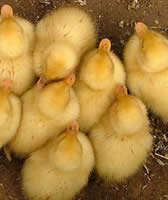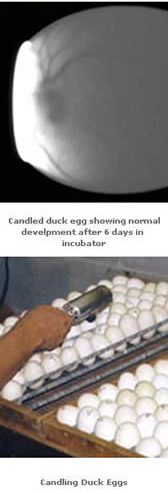Hatching Duck Eggs

Much of the information available on incubating and hatching chicken eggs can be applied to ducks, as long as the important differences between these two species are taken into account. Since duck eggs are larger than chicken eggs, setting trays must be designed to accommodate their larger size. Eggs from common ducks like Pekins require 28 days to hatch.
Eggs from Muscovy ducks hatch in about 35 days after setting. When larger numbers of duck eggs are to be hatched, large commercial incubators (setters) and hatchers are normally used. Pekin duck eggs are kept in a setter for 25 days and then transferred on the 25th day to a hatcher where they remain until they hatch on the 28th day. Eggs are automatically turned while in the setter (usually hourly). It is not  necessary to turn eggs in the hatcher. Basic procedures and conditions for hatching duck eggs are as follows.
necessary to turn eggs in the hatcher. Basic procedures and conditions for hatching duck eggs are as follows.
- If the incubator is not already in operation, start the incubator and allow the temperature and humidity to stabilize a day or two before setting eggs. Set the temperature at 37.5°C (99.5°F) and relative humidity at 55% (84.5°F on wet bulb thermometer). Set ventilation as recommended by the incubator manufacturer. Eggs must be turned, either automatically or by hand, a minimum of 4 times a day. Most automatic turning devices are set to change the position of the eggs hourly.
- Select eggs to be set by carefully inspecting and candling them at the time they are put in setting trays. Do not set eggs that are cracked, double yolked, misshapen, oversized, undersized or dirty. For best results, set eggs within 1-3 days from the time they were laid. There is an average loss of about 3% hatchability for eggs stored 7 days before setting, and about 10% loss for those stored 14 days. Always set eggs with the small end down, except in the case of small incubators that have no trays. If eggs have been stored in a cooler, take them out of the cooler the night before setting and allow them to warm to room temperature.
- On the day of setting, put eggs in incubator, close the doors and allow the incubator to reach operating temperature. Check frequently to make sure the incubator is working properly the first day, and continue checking thereafter at least four times a day.
- At about seven days after setting, candle the eggs and remove any eggs that are infertile (clear) or have dead germ (cloudy).
- At 25 days after setting (Pekin eggs), the eggs are transferred to hatching trays, and if eggs are hatched in a separate machine, moved to the hatcher. Candle and remove eggs with dead embryos. At the time of transfer, the temperature of the hatcher should be set at 37.2°C (99°F) and the humidity set at 65% (88°F wet bulb). As the hatch progresses, and eggs begin to pip, increase the humidity to 80% (93°F wet bulb), and increase ventilation openings by about 50%. As the hatch nears completion gradually lower the temperature and humidity so that by the end of the hatch the temperature is at 36.1°C (97°F), and the humidity is at 70% (90°F wet bulb). Vents should be opened to their maximum setting by the end of the hatch. Remove ducklings from the hatcher when 90-95% of them are dry.
Proper Water Loss During Incubation
As the duckling develops inside the egg there is a loss of water from the egg and an increase in the size of the air cell. If the duckling is developing normally, the air cell should occupy about one-third of the space inside the egg at 25 days of incubation (common ducks). Weight loss can also be used as a guide. Common duck eggs should lose about 14% of their weight at time of setting by 25 days.
Natural Incubation
Duck eggs may be hatched naturally by placing them under a broody duck or even a broody chicken hen. Muscovy ducks are very good setters, capable of hatching 12-15 duck eggs. The nest box should be located in a clean dry shelter, bedded with suitable litter. Feed and water should be available for the broody duck and for the ducklings when they hatch.
Egg Storage
If eggs are stored for a while before they are set, they should be stored at a temperature and humidity level that will minimize deterioration of the egg. For a small number of eggs, storage in a cellar may suffice. Whenever possible, store eggs at about 55°F (13°C) and 75% of relative humidity. Store eggs small end down.


